Kingdom of Hungary
Kingdom of Hungary Names ↓ | |||||||||||||||||||||
|---|---|---|---|---|---|---|---|---|---|---|---|---|---|---|---|---|---|---|---|---|---|
| 1000–1918[a]
1920–1946 | |||||||||||||||||||||
| Motto:Regnum Mariae Patronae Hungariae(Latin)[1] Mária királysága, Magyarország védőnője(Hungarian) Kingdom of Mary, the Patroness of Hungary(English) | |||||||||||||||||||||
| Anthem:"Himnusz"(1844–1946) "Hymn" Royal anthem God save, God protect Our Emperor, Our Country! (1797–1918) | |||||||||||||||||||||
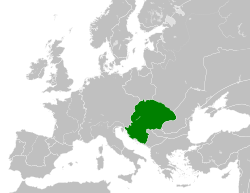 The Kingdom of Hungary (green) in 1190 | |||||||||||||||||||||
 The Kingdom of Hungary (dark green) andKingdom of Croatia-Slavonia(light green) withinAustria-Hungaryin 1914 | |||||||||||||||||||||
| Capital | Budapest
Historical capitals: | ||||||||||||||||||||
| Official languages | Other spoken languages: Carpathian Romani,Croatian,Polish,Romanian,Ruthenian,Serbian,Slovak,Slovene,Yiddish | ||||||||||||||||||||
| Religion | Catholicism(LatinandEastern Catholic),[2]Calvinism,Lutheranism,Eastern Orthodoxy,Unitarianism,Judaism | ||||||||||||||||||||
| Demonym(s) | Hungarian | ||||||||||||||||||||
| Government | Feudal monarchy(1000–1301) Absolute monarchy(1301–1868) Unitaryparliamentaryconstitutional monarchy(1848–1918; 1920–46) | ||||||||||||||||||||
| Monarch | |||||||||||||||||||||
• 1000–38 (first) | Stephen I | ||||||||||||||||||||
• 1916–18 (last) | Charles IV | ||||||||||||||||||||
• 1920–44 (Regent) | Miklós Horthy | ||||||||||||||||||||
| Palatine | |||||||||||||||||||||
• 1009–38 (first) | Samuel Aba | ||||||||||||||||||||
• 1847–48 (last) | Stephen Francis Victor | ||||||||||||||||||||
| Prime Minister | |||||||||||||||||||||
• 1848 (first) | Lajos Batthyány | ||||||||||||||||||||
• 1945–46 (last) | Zoltán Tildy | ||||||||||||||||||||
| Legislature | Diet(from the 1290s) | ||||||||||||||||||||
| House of Magnates (1867–1918; 1926–45) | |||||||||||||||||||||
| House of Representatives (1867–1918; 1927–45) | |||||||||||||||||||||
| Historical era | 2nd millennium | ||||||||||||||||||||
• Coronation ofStephen I | 25 December 1000 | ||||||||||||||||||||
| 24 April 1222 | |||||||||||||||||||||
| 11 April 1241 | |||||||||||||||||||||
| 29 August 1526 | |||||||||||||||||||||
| 29 August 1541 | |||||||||||||||||||||
| 26 January 1699 | |||||||||||||||||||||
| 15 March 1848 | |||||||||||||||||||||
| 30 March 1867 | |||||||||||||||||||||
| 4 June 1920 | |||||||||||||||||||||
| 1 February 1946 | |||||||||||||||||||||
| Area | |||||||||||||||||||||
| 1200[3] | 282,870 km2(109,220 sq mi) | ||||||||||||||||||||
| 1910[5] | 282,870 km2(109,220 sq mi) | ||||||||||||||||||||
| 1930[6] | 93,073 km2(35,936 sq mi) | ||||||||||||||||||||
| 1941[7] | 172,149 km2(66,467 sq mi) | ||||||||||||||||||||
| Population | |||||||||||||||||||||
• 1200[3] | 2,000,000 | ||||||||||||||||||||
• 1790[4] | 8,000,000 | ||||||||||||||||||||
• 1910[5] | 18,264,533 | ||||||||||||||||||||
• 1930[6] | 8,688,319 | ||||||||||||||||||||
• 1941[7] | 14,669,100 | ||||||||||||||||||||
| Currency | |||||||||||||||||||||
| |||||||||||||||||||||
| Today part of | Hungary | ||||||||||||||||||||
TheKingdom of Hungarywas amonarchyinCentral Europethat existed for nearly a millennium, from 1000 to 1946. ThePrincipality of Hungaryemerged as a Christian kingdom upon thecoronationof the first kingStephen IatEsztergomaround the year 1000;[8]his family (theÁrpád dynasty) led the monarchy for 300 years. By the 12th century, the kingdom became a European power.[8]
Due to theOttomanoccupation of the central and southern territories of Hungary in the 16th century, the country was partitioned into three parts: the HabsburgRoyal Hungary,Ottoman Hungary,and the semi-independentPrincipality of Transylvania.[8]TheHouse of Habsburgheld the Hungarian throne after theBattle of Mohácsin 1526 continuously until 1918 and also played a key role in the liberation wars against the Ottoman Empire.
From 1867, territories connected to the Hungarian crown were incorporated intoAustria-Hungaryunder the name ofLands of the Crown of Saint Stephen.The monarchy ended with the deposition of the last kingCharles IVin 1918, after which Hungary became a republic. The kingdom was nominally restored during the "Regency"of 1920–46, ending under theSoviet occupationin 1946.[8]
The Kingdom of Hungary was amultiethnic[9]state from its inception[10]until theTreaty of Trianonand it covered what is todayHungary,Slovakia,Transylvaniaand other parts ofRomania,Carpathian Ruthenia(now part ofUkraine),Vojvodina(now part ofSerbia), the territory ofBurgenland(now part ofAustria),Međimurje(now part ofCroatia),Prekmurje(now part ofSlovenia) and a few villages which are now part ofPoland.From 1102 it also included theKingdom of Croatia,being inpersonal unionwith it, united under theKing of Hungary.
According to the demographers, about 80 percent of the population was made up ofHungariansbefore theBattle of Mohács,however in the mid-19th century out of a population of 14 million less than 6 million were Hungarian due to the resettlement policies and continuous immigration from neighboring countries.[11][12]Major territorial changes made Hungary ethnically homogeneous afterWorld War I.More than nine-tenths of the population of modern Hungary is ethnically Hungarian and speaksHungarianas their mother tongue.
Today, the feast day of the first kingStephen I(20 August) is anational holidayin Hungary, commemorating the foundation of the state (Foundation Day).[13]
Names
[edit]TheLatinformsRegnum HungariaeorUngarie(Regnummeaning kingdom);Regnum Marianum(Kingdom ofMary); or simplyHungaria,were the names used in official documents in Latin from the beginning of the kingdom to the 1840s.
TheGermannameKönigreich Ungarnwas used officially from 1784 to 1790[14]and again between 1849 and the 1860s.
TheHungarianname (Magyar Királyság) was used in the 1840s, and then again from the 1860s to 1946. The unofficial Hungarian name of the kingdom wasMagyarország,[15]which is still the colloquial, and also the official name of Hungary.[16]
The names in the other native languages of the kingdom were:Polish:Królestwo Węgier,Romanian:Regatul Ungariei,Serbian:Kraljevina Ugarska,Croatian:Kraljevina Ugarska,Slovene:Kraljevina Ogrska,Slovak:Uhorské kráľovstvo,andItalian(for the city ofFiume),Regno d'Ungheria.
In Austria-Hungary (1867–1918), the unofficial nameTransleithaniawas sometimes used to denote the regions of the Kingdom of Hungary. Officially, the termLands of the Crown of Saint Stephenwas included for the Hungarian part of Austria-Hungary, although this term was also in use prior to that time.
Capital cities
[edit]| Name | Time period |
|---|---|
| Székesfehérvár | 1000–1543 |
| Esztergom | 1000–1256 |
| Buda | 1256–1315 |
| Temesvár (nowTimișoara) | 1315–1323 |
| Visegrád | 1323–1408 |
| Buda | 1408–1485 |
| Vienna(Bécs) | 1485–1490 |
| Buda | 1490–1536 (1541) |
| Lippa (nowLipova) –Eastern Hungarian Kingdom | 1541–1542 |
| Gyulafehérvár (nowAlba Iulia) – Eastern Hungarian Kingdom | 1542–1570 |
| Pressburg (Pozsony, nowBratislava) | 1536–1848 |
| Buda | 1848–1849 |
| Debrecen | 1849 |
| Buda | 1849–1873 |
| Budapest | 1873–1944 |
| Debrecen | 1944 |
| Budapest | 1944–1946 |
History
[edit]Origins
[edit]The Hungarians, led byÁrpád,settled the Carpathian Basin in 895 and established thePrincipality of Hungary(896–1000).[17]The Hungarians led several successfulincursionsto Western Europe, until they were stopped byOtto I, Holy Roman EmperorinBattle of Lechfeld.
Middle Ages
[edit]This sectionneeds additional citations forverification.(December 2019) |
High Middle Ages
[edit]
The principality was succeeded by the Christian Kingdom of Hungary with the coronation of St Stephen I (son of principal Géza. Originally called Vajk until baptized) atEsztergomon Christmas Day 1000. The first kings of the kingdom were from theÁrpád dynasty.He fought againstKoppányand in 998, withBavarianhelp, defeated him nearVeszprém.The Catholic Church received powerful support from Stephen I, who with Christian Hungarians and German knights wanted a Christian kingdom established in Central Europe.Stephen I of Hungarywascanonizedas aCatholicsaintin 1083 and anEastern Orthodoxsaint in 2000. Around the 11th century, the Kingdom of Hungary became aChristian state,[18]andCatholicismin the Hungarian Kingdom was astate religion.[19][20]
After his death, a period of revolts and conflict for supremacy ensued between the royalty and the nobles. In 1051 armies of theHoly Roman Empiretried to conquer Hungary, but they were defeated atVértes Mountain.The armies of the Holy Roman Empire continued to suffer defeats; the second greatest battle was at the town now calledBratislava,in 1052. Before 1052 Peter Orseolo, a supporter of theHoly Roman Empire,was overthrown by kingSamuel Aba of Hungary.[21][22]
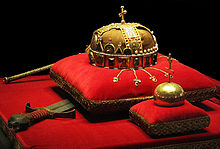
This period of revolts ended during the reign ofBéla I.Hungarian chroniclers praisedBéla Ifor introducing new currency, such as the silver denarius, and for his benevolence to the former followers of his nephew, Solomon. The second greatest Hungarian king, also from the Árpád dynasty, wasLadislaus I of Hungary,who stabilized and strengthened the kingdom. He was also canonized as a saint. Under his rule Hungarians successfully fought against theCumansand acquired parts ofCroatiain 1091. Due to a dynastic crisis in Croatia, with the help of the local nobility who supported his claim, he managed to swiftly seize power in northern parts of the Croatian kingdom (Slavonia), as he was a claimant to the throne due to the fact that his sister was married to the late Croatian kingZvonimirwho died without an heir.

However, kingship over all of Croatia would not be achieved until the reign of his successorColoman.With the coronation of King Coloman as "King of Croatia and Dalmatia"inBiogradin 1102, the two kingdoms of Croatia and Hungary were united under one crown.[23][24]Although the precise terms of this relationship became a matter of dispute in the 19th century, it is believed that Coloman created akind of personal union between the two kingdoms.The nature of the relationship varied through time, Croatia retained a large degree of internal autonomy overall, while the real power rested in the hands of the local nobility.[25]Modern Croatian and Hungarian historiographies mostly view the relations betweenKingdom of Croatia (1102–1526)and Kingdom of Hungary from 1102 as a form of apersonal union,i.e. that they were connected by a common king.[26]Also, one of the greatest Hungarian jurists and statesmen of the 16th century,István Werbőczyin his workTripartitumtreats Croatia as a kingdom separate to Hungary.
EspeciallyArabicandByzantinetravelers from this time praised the richness country, the dense pastures, the nicely cultivated lands, the plentiful animals in waters and forests. They said that the wheat is cheap, the markets are populous, the cities flourish and the folk are wealthy. Although it is hardly credible that they refer to all layers of society, the documents were inspired by the reality.[27]
In 1222Andrew II of Hungaryissued theGolden Bullwhich laid down the principles of law.
Mongol invasion
[edit]
In 1241, Hungary was invaded by theMongolsand while the first minor battles with Subutai's vanguard probes ended in seeming Hungarian victories, the Mongols finally destroyed the combined Hungarian and Cuman armies at theBattle of Muhi.In 1242, after the end of the Mongol invasion, numerous fortresses to defend against future invasion were erected byBéla IV of Hungary.In gratitude, the Hungarians acclaimed him as the "Second Founder of the Homeland", and the Hungarian Kingdom again became a considerable force in Europe. In 1260Béla IVlost the War of Babenberg Succession, his army was defeated at theBattle of Kressenbrunnby the united Bohemian forces. However, in 1278,Ladislaus IV of Hungaryand Austrian troops fully destroyed the Bohemian army at theBattle on the Marchfeld.
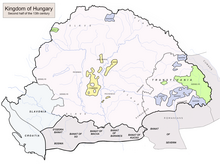
Late Middle Ages
[edit]The Árpád dynasty died out in 1301 with the death ofAndrew III.Subsequently, Hungary was ruled by theAngevinsuntil the end of the 14th century, and then by several non-dynastic rulers – notablySigismund, Holy Roman EmperorandMatthias Corvinus– until the early 16th century.
The Anjou Age
[edit]

When Andrew III's predecessor,Ladislaus IV,was assassinated in 1290, another nobleman was set up as titular King of Hungary:Charles Martel of Anjou.Charles Martel was the son of KingCharles II of NaplesandMary of Hungary,the sister of Ladislaus IV. However, Andrew III took the crown for himself and ruled without inconvenience after Charles Martel's death in 1295. Upon Andrew's death in 1301, the country was divided betweenpowerful lordshostile to each other. A coalition of some of these oligarchs first crownedWenceslaus III,who quickly fled from the anarchy, thenOtto III,who was forced to leave by theKán family.Charles, remaining as the only candidate, was finally crowned KingCharles Iin 1310.His famous battle at Rozgony,described as "most cruel battle since theMongol invasion of Europe"by theChronicon Pictum,endedhis war of reunification.[28][29]
He implemented considerable economic reforms and defeated the remaining nobility who were in opposition to royal rule, led byMáté Csák III.The kingdom of Hungary reached an age of prosperity and stability under Charles I. The gold mines of the Kingdom were extensively worked and soon Hungary reached a prominent standing in European gold production. Theforintwas introduced as a currency, replacing thedenars,and soon after Charles's reforms were implemented, the economy of the Kingdom started to prosper again, having fallen into a parlous state following the Mongol invasion.
Charles exalted the cult to Saint Ladislaus I, using him as a symbol of bravery, justice and purity. He also venerated his uncle,Saint Louis of Toulouse.On the other hand, he gave importance to the cults of the princessesSaint ElizabethandSaint Margaret,which added relevance to the lineage inheritance through the feminine branches.[30]
Charles restored the royal power which had fallen into feudal lords' hands, and then made the lords swear loyalty to him. For this, he founded in 1326 theOrder of Saint George,which was the first secularchivalric orderin the world, and included the most important noblemen of the Kingdom.

Charles married four times. His fourth wife wasElizabeth,the daughter ofWładysław I of Poland.When Charles died in 1342, his eldest son by Elizabeth succeeded him asLouis I.In the first years of his reign, Louis was advised closely by his mother, making her one of the most influential personalities in the Kingdom.
Charles had arranged the marriage of his second son,Andrew,with his cousinJoanna,the granddaughter of KingRobert of Naples,in 1332. Robert died in 1343, bequeathing his kingdom to Joanna but excluding the claim of Andrew. In 1345, a group of noble Neapolitan conspirators murdered Andrew atAversa.Almost immediately, Louisdeclared war on Naples,conducting a first campaign in 1347–1348 and a second in 1350. He eventually signed peace with Joanna in 1352. Louis also waged wars against theSerbian Empireand theGolden Horde,restoring the Hungarian monarchs' authority over territories along the frontiers which had been lost during the previous decades.
In 1370 Louis's uncle,Casimir III of Poland,died without male issue. Louis succeeded him, thus establishing the firstunion of Hungary and Poland.This lasted until 1382 when Louis himself died without male issue; his two daughters,MaryandJadwiga,then ascended the thrones of Hungary and Poland respectively.
The Age of Sigismund
[edit]
Louis I of Hungaryalways kept good and close relationships with theHoly Roman EmperorCharles IV of Luxembourgand finally proclaimed Charles's sonSigismund of Luxembourgto succeed him as King of Hungary. Sigismund became a renowned king who created many improvements in the Hungarian law system and who rebuilt the palaces of Buda and Visegrád. He brought materials from Austria and Bohemia and ordered the creation of the most luxurious building in all of central Europe. In his laws can be seen the traces of the earlymercantilism.He worked hard to keep the nobility under his control. A great part of his reign was dedicated to the fight with the Ottoman Empire, which started to extend its frontiers and influence to Europe. In 1396 was fought theBattle of Nicopolisagainst the Ottomans, which resulted in a defeat for the Hungarian-French forces led by Sigismund andPhilip of Artois, Count of Eu.However, Sigismund continued to successfully contain the Ottoman forces outside of the Kingdom for the rest of his life.
Losing popularity among the Hungarian nobility, Sigismund soon became victim of an attempt against his rule, andLadislaus of Anjou-Durazzo(the son of the murdered King of Naples Charles II of Hungary) was called in and crowned. Since the ceremony was not performed with the Hungarian Holy Crown, and in the city ofSzékesfehérvár,it was considered illegitimate. Ladislaus stayed only few days in Hungarian territory and soon left it, no longer an inconvenience for Sigismund. In 1408 he founded theOrder of the Dragon,which included most of the relevant monarchs and noblemen of that region of Europe at that time. This was just a first step for what was coming. In 1410 he was electedKing of the Romans,making him the supreme monarch over the German territories. He had to deal with theHussitemovement, a religious reformist group that was born in Bohemia, and he presided at theCouncil of Constance,where the theologist founderJan Hus,was judged. In 1419 Sigismund inherited theCrown of Bohemiaafter the death of his brotherWenceslaus of Luxembourg,obtaining the formal control of three medieval states, but he struggled for control of Bohemia until the peace agreement with the Hussites and his coronation in 1436. In 1433 was crowned as Holy Roman Emperor by the Pope and ruled until his death in 1437, leaving as his only heir his daughterElizabeth of Luxembourgand her husband. The marriage of Elizabeth was arranged with the DukeAlbert V of Austria,who was later crowned as King Albert of Hungary in 1437.
Hunyadi family
[edit]

The Hungarian kingdom's golden age was during the reign ofMatthias Corvinus(1458–1490), the son ofJohn Hunyadi.His nickname was "Matthias the Just". He further improved the Hungarian economy and practised astute diplomacy in place of military action whenever possible. Matthias did undertake campaigning when necessary. From 1485 until his death, he occupied Vienna, aiming to limit the influence and meddling of the Holy Roman Empire in Hungary's affairs.
At the time of the initial Ottoman encroachment, the Hungarians successfully resisted conquest. John Hunyadi was leader of theCrusade of Varna,in which the Hungarians tried to expel the Turks from the Balkans. Initially, they were successful, but later at theBattle of Varna,the Ottomans won a decisive ifPyrrhic victory.Wladyslaw IIIwas decapitated during this battle.
In 1456, John Hunyadi delivered a crushing defeat of the Ottomans at theSiege of Belgrade.TheNoon Bellcommemorates the fallen Christian warriors. In the 15th century, theBlack Army of Hungarywas a modern mercenary army, with theHussarsthe most skilled troops of theHungarian cavalry.In 1479, under the leadership ofPál Kinizsi,the Hungarian army destroyed the Ottoman and Wallachian troops at theBattle of Breadfield.The army of Hungary destroyed its enemies almost every time when Matthias was king.[citation needed]
Matthias died without legitimate heir, and was thus succeeded byVladislaus IIJagiellon(1490–1516), the son ofCasimir IV of Poland.In turn, Vladislaus was succeeded by his sonLouis II(1516–26).
In 1526, at theBattle of Mohács,the forces of theOttoman Empireled bySuleiman the Magnificentannihilated the Hungarian army. In trying to escape, Louis II drowned in the Csele Creek. The leader of the Hungarian army,Pál Tomori,also died in the battle.
Early modern history
[edit]The divided kingdom
[edit]Due to a serious defeat by the Ottomans (Battle of Mohács) the central authority collapsed. The majority of Hungary's ruling elite electedJohn Zápolya(10 November 1526). A small minority of aristocrats sided withFerdinand I, Holy Roman Emperor,who was Archduke ofAustria,and was related to Louis by marriage. Due to previous agreements that theHabsburgswould take the Hungarian throne if Louis died without heirs, Ferdinand was elected king by a rumpdietin December 1526.
Although the borders shifted frequently during this period, the three parts can be identified, more or less, as follows:
- Royal Hungary,which consisted of northern and western territories where Ferdinand I was recognized as king of Hungary. This part is viewed as defining the continuity of the Kingdom of Hungary. The territory along with Ottoman Hungary suffered greatly from the nearly constant wars taking place.
- Ottoman Hungary:TheGreat Alföld(i.e. most of present-day Hungary, including south-eastern Transdanubia and theBanat), partly without north-eastern present-day Hungary.
- Eastern Hungarian Kingdomunder theSzapolyai.This territory, often under Ottoman influence, was different from Transylvania proper and included various other territories sometimes referred to asPartium.Later the entity was calledPrincipality of Transylvania.
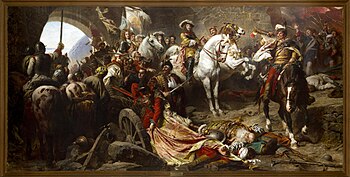
On 29 February 1528, KingJohn I of Hungaryreceived the support of the Ottoman Sultan. A three-sided conflict ensued as Ferdinand moved to assert his rule over as much of the Hungarian kingdom as he could. By 1529 the kingdom had been split into two parts: Habsburg Hungary and the "eastern-Kingdom of Hungary". At this time there were no Ottomans on Hungarian territories, except Srem's important castles. In 1532,Nikola JurišićdefendedKőszegand stopped a powerful Ottoman army. By 1541, the fall ofBudamarked a further division of Hungary into three areas. The country remained divided until the end of the 17th century.
In 1547, theTruce of Adrianoplewas signed betweenCharles VandSuleiman the Magnificent.Through this treaty,Ferdinand I of AustriaandCharles Vrecognized total Ottoman control of Hungary,[31]and agreed to pay to the Ottomans a yearly tribute of 30,000 gold florins for their Habsburg possessions in northern and western Hungary.[32][33]
On 1 May 1566,Suleiman Iled an Ottoman invasion of Habsburg-controlled Hungary, the Ottoman forces of which was one of the most sizable armies he had led in his rule of 46 years.[34]After reaching Belgrade and met withJohn II Sigismund Zápolyaon 27 June, Suleiman I learned that a Croatian-Hungarian nobleman,Nikola IV Zrinski,Ban of Croatia, accomplished an attack on an Ottoman military camp at Siklós.[35][36]Suleiman I held off his attack of Eger for the time being, and began to set off towards Nikola IV Zrinski's fortress atSzigetvár.From 2 August to 7 September, the Ottoman forces had laid siege to the fortress with a force, at the least, of 150,000 against Zrinski's 2,300 defenders. While thesiegeturned into a victory for the Ottomans, it came at the cost of: 25,000 Ottoman soldiers and Suleiman I, who before the final battle of Szigetvár, due to natural causes of old age and illness.[35]
In the following centuries there were numerous attempts to push back theOttomanforces, such as theLong Waror Thirteen Years' War (29 July 1593 – 1604/11 November 1606) led by a coalition of Christian forces. In 1644 the Winter Campaign byMiklós Zrínyiburnt the crucial Suleiman Bridge ofOsijekin easternSlavonia,interrupting a Turkish supply line in Hungary. At theBattle of Saint Gotthard (1664),Austrians and Hungarians defeated the Turkish army.
After the Ottoman siege of Vienna failed in 1683, the Habsburgs went on the offensive against the Turks. By the end of the 17th century, they managed to invade the remainder of the historical Kingdom of Hungary and the principality of Transylvania. For a while in 1686, the capital Buda was again free from the Ottoman Empire, with the aid of other Europeans.
The Kuruc age
[edit]
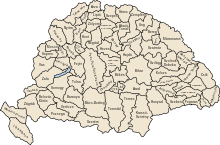



Rákóczi's War for Independence (1703–1711) was the first significant freedom fight in Hungary against absolutist Habsburg rule. It was fought by a group of noblemen, wealthy and high-ranking progressives who wanted to put an end to the inequality of power relations, led by Francis II Rákóczi (II. Rákóczi Ferenc in Hungarian). Its main aims were to protect the rights of the different social orders, and to ensure the economic and social development of the country. Due to the adverse balance of forces, the political situation in Europe and internal conflicts the freedom fight was eventually suppressed, but it succeeded in keeping Hungary from becoming an integral part of the Habsburg Empire, and its constitution was kept, even though it was only a formality.
After the departure of the Ottomans, the Habsburgs dominated the Hungarian Kingdom. The Hungarians' renewed desire for freedom led to Rákóczi's War for Independence. The most important reasons of the war were the new and higher taxes and a renewed Protestant movement. Rákóczi was a Hungarian nobleman, son of the legendary heroineIlona Zrínyi.He spent a part of his youth in Austrian captivity. TheKurucswere troops of Rákóczi. Initially, theKurucarmy attained several important victories due to their superior light cavalry. Their weapons were mostly pistols, light sabre andfokos.At theBattle of Saint Gotthard (1705),János Bottyándecisively defeated the Austrian army. The Hungarian colonelÁdám Baloghnearly capturedJoseph I,the King of Hungary and Archduke of Austria.
In 1708, the Habsburgs finally defeated the main Hungarian army atBattle of Trencsén,and this diminished the further effectiveness of the Kuruc army. While the Hungarians were exhausted by the fights, the Austrians defeated the French army in theWar of the Spanish Succession.They could send more troops to Hungary against the rebels. Transylvania became part of Hungary again starting at the end of the 17th century, and was led by governors.[38][39]
Age of Enlightenment
[edit]In 1711, Austrian EmperorCharles VIbecame the next ruler of Hungary. Throughout the 18th century, the Kingdom of Hungary had its own diet (parliament) and constitution, but the members of the Governor's Council (Helytartótanács,the office of thepalatine) were appointed by the Habsburg monarch, and the superior economic institution, theHungarian Chamber,was directly subordinated to theCourt ChamberinVienna.
The Hungarian language reform started under the reign ofJoseph II.The reform age of Hungary was started byIstván Széchenyia Hungarian noble, who built one of the greatest bridges of Hungary, theSzéchenyi Chain Bridge.Theofficial languageremained Latin until 1836, when Hungarian was introduced.[40][41]Between 1844 and 1849, and from 1867 onward, Hungarian became the exclusively used official language.
Hungarian Revolution of 1848
[edit]The European revolutions of 1848 swept into Hungary, as well. The Hungarian Revolution of 1848 sought to redress the long suppressed desire for political change, namely independence. The Hungarian National Guard was created by young Hungarian patriots in 1848. In literature, this was best expressed by the greatest poet of the revolution,Sándor Petőfi.
As war broke out with Austria, Hungarian military successes, which included the campaigns of the Hungarian general,Artúr Görgey,forced the Austrians on the defensive. One of the most famous battles of the revolution, theBattle of Pákozd,was fought on 29 September 1848, when the Hungarian revolutionary army led by Lieutenant-General János Móga defeated the troops of the Croatian BanJosip Jelačić.Fearing defeat, the Austrians pleaded for Russian help. The combined forces of the two empires quelled the revolution. The desired political changes of 1848 were again suppressed until theAustro-Hungarian Compromise of 1867.
Population 1910 (Kingdom of Hungary withoutKingdom of Croatia-Slavonia)[42]
| Ethnicity | Number | Percentage |
|---|---|---|
| Hungarian | 9 944 627 | 54.44% |
| Romanian | 2 948 186 | 16.14% |
| Slovak | 1 946 357 | 10.65% |
| German | 1 903 357 | 10.42% |
| Ruthenian | 464 270 | 2.54% |
| Serbian | 461 516 | 2.52% |
| Croatian | 194 808 | 1.06% |
| Other | 401 412 | 2.19% |
| All | 18 264 533 | 100% |
Population 1910 (Lands of the Crown of Saint Stephen)[43]
| Land | Hungarian | Romanian | German | Slovak | Croatian | Serbian | Ruthenian | Other | Total |
|---|---|---|---|---|---|---|---|---|---|
| DanubeRight Bank | 72% (2,221,295) | 0% (833) | 18% (555,694) | 0.6% (17,188) | 5.5% (168,436) | 0.5% (15,170) | 0% (232) | 3.4% (105,556) | 14.8% (3,084,404) |
| Danube Left Bank | 32.7% (711,654) | 0% (704) | 6.6% (144,395) | 58.8% (1,279,574) | 0.1% (2,294) | 0% (200) | 0% (393) | 1.7% (36,710) | 10.4% (2,175,924) |
| Danube-Tisza | 81.2% (3,061,066) | 0.1% (4,813) | 9.5% (357,822) | 2.1% (79,354) | 0.1% (4,866) | 4.1% (154,298) | 0.3% (11,121) | 4.1% (96,318) | 18% (3,769,658) |
| TiszaRight Bank | 53.5% (945,990) | 0.1% (1,910) | 5.6% (98,564) | 25% (441,776) | 0% (486) | 0% (247) | 14.3% (253,062) | 1.6% (27,646) | 8.5% (1,769,681) |
| Tisza Left Bank | 61.8% (1,603,924) | 24% (621,918) | 3.2% (83,229) | 3.1% (81,154) | 0% (327) | 0% (321) | 7.5% (194,504) | 0.3% (8,547) | 12.4% (2,594,924) |
| Tisza-Maros | 22.2% (474,988) | 39.5% (845,850) | 19.9% (427,253) | 2.1% (44,715) | 0.2% (4,950) | 13.6% (290,434) | 0.1% (3,188) | 2.4% (50,391) | 10.3% (2,141,769) |
| Transylvania | 34.3% (918,217) | 55% (1,472,021) | 8.7% (234,085) | 0.1% (2,404) | 0% (523) | 0% (421) | 0.1% (1,759) | 1.8% (48,937) | 12.8% (2,678,367) |
| Fiume | 13% (6,493) | 0.3% (137) | 4.6% (2,315) | 0.4% (192) | 26% (12,926) | 0.9% (425) | 0% (11) | 54.8 (27,307, mostlyItalian) | 0.2% (49,806) |
| Croatia-Slavonia | 4% (105,948) | 0% (846) | 5.1% (134,078) | 0.8% (21,613) | 62.5% (1,638,354) | 24.6% (644,955) | 0.3% (8,317) | 2.6% (67,843) | 12.6% (2,621,954) |
| Total | 48.1% (10,050,575) | 14.1% (2,949,032) | 9.8% (2,037,435) | 9.4% (1,967,970) | 8.8% (1,833,162) | 5.3% (1,106,471) | 2.3% (472,587) | 2.2% (469,255) | 100% (20,886,487) |
Austria-Hungary (1867–1918)
[edit]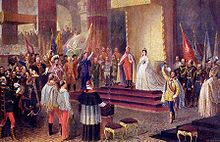
Following theAustro-Hungarian Compromise of 1867,the Habsburg Monarchy became the "dual monarchy" ofAustria-Hungary.The Austro-Hungarian economy changed dramatically during the existence of the Dual Monarchy. Technological change accelerated industrialization and urbanization. The capitalist way of production spread throughout the Empire during its fifty-year existence and obsolete medieval institutions continued to disappear. By the early 20th century, most of the Empire began to experience rapid economic growth. TheGNP per capitagrew roughly 1.45% per year from 1870 to 1913. That level of growth compared very favorably to that of other European nations such as Britain (1.00%), France (1.06%), and Germany (1.51%).
The lands of the Hungarian Crown (comprising the Kingdom of Hungary proper, into which Transylvania was fully incorporated, and theKingdom of Croatia-Slavonia,which maintained a distinct identity and internal autonomy) were granted equal status with the Austrian Empire. Each of the two states comprising Austria-Hungary exercised considerable independence, with certain institutions, notably the reigning house, defence, foreign affairs, and finances for common expenditures, remaining under joint management. This arrangement lasted until 1918, when theCentral Powerswent down in defeat inWorld War I.
Transitions (1918 to 1920)
[edit]Two short-lived republics
[edit]TheHungarian Soviet RepublicorHungarian Republic of Councils(Hungarian:Magyarországi Tanácsköztársaság[44]orMagyarországi Szocialista Szövetséges Tanácsköztársaság[45]) was a short-lived independentcommunist stateestablished inHungary.
It lasted only from 21 March until 1 August 1919. The state was led byBéla Kunand was not recognized by France, the UK or the US.[46]It was the second socialist state in the world to be formed after theOctober RevolutioninRussiabrought theBolsheviksto power. The Hungarian Republic of Councils hadmilitary conflictswith theKingdom of Romania(seeHungarian–Romanian War), theKingdom of Serbs, Croats and Slovenesand the evolvingCzechoslovakia.It collapsed on 1 August 1919 when Hungarians sent representatives to negotiate their surrender to theRomanianforces and Béla Kun, together with other high-ranking Communists, fled to Austria.[47]
A 1919 attempt to form a federation with theKingdom of Romaniaalso failed, when the Romanian King ultimately refused to accept the Hungarian Crown.[48]
The restoration of the Kingdom
[edit]After the pullout of occupation forces ofRomaniain 1920 the country went into civil conflict, with Hungariananti-communistsandmonarchistspurging the nation of communists and others by whom they felt threatened. On 29 February 1920, after the pullout of the last of the Romanian occupation forces, the Kingdom of Hungary was restored, a coalition of right-wing political forces united and reinstated Hungary's status as a constitutional monarchy. Selection of the new King was delayed due to civil infighting, and aregentwas appointed to represent the monarchy, former Austro-Hungarian navy admiralMiklós Horthy.
Treaty of Trianon (1920)
[edit]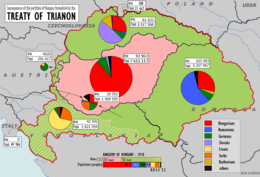
The new borders set in 1920 by theTreaty of Trianonceded 72% of the territory of the Kingdom of Hungary to the neighbouring states. The main beneficiaries wereRomania,the newly formed states ofCzechoslovakia,and theKingdom of Serbs, Croats and Slovenes,butAustria,PolandandItalyalso gained smaller territories. The areas that were allocated to neighbouring countries in total (and each of them separately) possessed a majority of non-Hungarian population, but more than 3.3 million ethnic Hungarians were left outside the new borders of Hungary. Many[who?]view this as contrary to the terms laid out by US PresidentWoodrow Wilson'sFourteen Points,[citation needed]which were intended to honour the ethnic makeup of the territories. As President Wilson left the conference to emphasize his disagreement, and because the US Congress did not ratify the treaty, the United States of America and the Kingdom of Hungary signed a separate peace treaty on 29 August 1921.[52]
Between 1920 and 1946
[edit]Interwar period
[edit]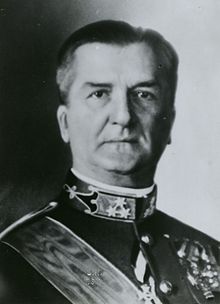
The new international borders separated Hungary's industrial base from its sources of raw materials and its former markets for agricultural and industrial products. Hungary lost 84% of its timber resources, 43% of its arable land, and 83% of its iron ore. Furthermore, post-Trianon Hungary possessed 90% of the engineering and printing industry of the Kingdom, while only 11% oftimberand 16%ironwas retained. In addition, 61% ofarable land,74% of public road, 65% of canals, 62% ofrailroads,64% of hard surface roads, 83% ofpig ironoutput, 55% of industrial plants, 100% of gold, silver, copper, mercury and salt mines, and 67% of credit and banking institutions of the prewar Kingdom of Hungary lay within the territory of Hungary's neighbors.[53][54][55]
Because most of the country's pre-war industry was concentrated near Budapest, Hungary retained about 51% of its industrial population and 56% of its industry. Horthy appointed CountPál Telekias Prime Minister in July 1920. His government issued anumerus claususlaw, limiting admission of "political insecure elements" (these were often Jews) to universities and, in order to quiet rural discontent, took initial steps towards fulfilling a promise of major land reform by dividing about 3,850 km2from the largest estates into smallholdings. Teleki's government resigned, however, afterCharles IVunsuccessfully attempted to retake Hungary's throne in March 1921. The return of King Charles produced split parties between conservatives who favored a Habsburg restoration and nationalist right-wing radicals who supported election of a Hungarian king. CountIstván Bethlen,a non-affiliated right-wing member of the parliament, took advantage of this rift forming a new Party of Unity under his leadership. Horthy then appointed Bethlen prime minister. Charles IV died soon after he failed a second time to reclaim the throne in October 1921. (For more detail on Charles's attempts to retake the throne, seeCharles IV of Hungary's conflict with Miklós Horthy.)

As prime minister, Bethlen dominated Hungarian politics between 1921 and 1931. He fashioned a political machine by amending the electoral law, providing jobs in the expanding bureaucracy to his supporters, and manipulating elections in rural areas. Bethlen restored order to the country by giving the radical counterrevolutionaries payoffs and government jobs in exchange for ceasing their campaign of terror against Jews and leftists. In 1921, he made a deal with the Social Democrats and trade unions (called Bethlen-Peyer Pact), agreeing, among other things, to legalize their activities and free political prisoners in return for their pledge to refrain from spreadinganti-Hungarianpropaganda, calling political strikes, and organizing the peasantry. Bethlen brought Hungary into theLeague of Nationsin 1922 and out of international isolation by signing a treaty of friendship withItalyin 1927. The revision of the Treaty of Trianon rose to the top of Hungary's political agenda and the strategy employed by Bethlen consisted by strengthening the economy and building relations with stronger nations. Revision of the treaty had such a broad backing in Hungary that Bethlen used it, at least in part, to deflect criticism of his economic, social, and political policies.
TheGreat Depressioninduced a drop in the standard of living and the political mood of the country shifted further toward the right. In 1932 Horthy appointed a new prime-minister,Gyula Gömbös,who changed the course of Hungarian policy towards closer cooperation with Germany. Gömbös signed a trade agreement with Germany that drew Hungary's economy out of depression but made Hungary dependent on the German economy for both raw materials and markets. On 2 November 1938, as the result of theFirst Vienna Awardparts of Czechoslovakia –Southern Slovakiaand a part of Carpathian Ruthenia – were returned to Hungary, an area amounting to 11,927 km2and a population of 869,299 (86.5% of which were Hungarians according to the 1941 census). Between 5 November and 10 November, Hungarian armed forces peacefully occupied the newly transferred territories.[56]Hitler later promised to transfer all of Slovakia to Hungary in exchange for a military alliance, but his offer was rejected. Instead, Horthy chose to pursue a territorial revision to be decided along ethnic lines. In March 1939, the Czecho-Slovak Republic was dissolved,Germany invaded it,and theProtectorate of Bohemia and Moraviawas established. On 14 March,Slovakiadeclared itself to be an independent state.
On 15 March,Carpatho-Ukrainedeclared itself to be an independent state. Hungary rejected the independence of Carpatho-Ukraine and, between 14 March and 18 March, Hungarian armed forces occupied the rest of Carpathian Ruthenia and ousted the government ofAvgustyn Voloshyn.By contrast, Hungary recognized the Nazipuppet stateof Slovakia led by theClerical FascistJozef Tiso.[57]In September 1940, with troops massing on both sides of the Hungarian-Romanian border, war was averted by theSecond Vienna Award.This award transferred the northern half ofTransylvaniato Hungary, with a total area of 43,492 km2and a total population of 2,578,100 with a 53.5% Hungarian majority according to the 1941 census. By dividing Transylvania between Romania and Hungary, Hitler was able to ease tensions in Hungary. In October 1940, the Germans initiated a reciprocity policy between Romania and Hungary which was continued until the end of World War II. The region ofSub-Carpathiawas given special autonomous status with the intention that (eventually) it would be self-governed by the Ruthenian minority.
During World War II 1941–1945
[edit]

After being granted part of southern Czechoslovakia and Subcarpathia by the Germans and Italians in theFirst Vienna Awardof 1938, and then northern Transylvania in theSecond Vienna Awardof 1940, Hungary participated in their first military maneuvers on the side of the Axis powers in 1941. Thus, the Hungarian army was part of theinvasion of Yugoslavia,gaining some more territory and joining theAxis powersin the process. On 22 June 1941, Germany invaded theSoviet UnioninOperation Barbarossa.Hungary joined the German effort and declared war on the Soviet Union on 26 June, and enteredWorld War IIon the side of the Axis. In late 1941, the Hungarian troops on the Eastern Front experienced success at theBattle of Uman.By 1943, after theRoyal Hungarian Armysuffered extremely heavy losses at the river Don, the Hungarian government sought to negotiate a surrender with the Allies. On 19 March 1944, as a result of this duplicity, German troops occupied Hungary in what was known asOperation Margarethe.By then it was clear that Hungarian politics would be suppressed according to Hitler's intention to hold the country in the war on the side of the Nazi Third Reich because of its strategic location. On 15 October 1944, Horthy made a token effort to disengage Hungary from the war. The Germans launchedOperation Panzerfaustand Horthy's regime was replaced by afascist puppet governmentunder the pro-GermanArrow CrossleaderFerenc Szálasi,thus effectively ending the possibility for independent actions in the war. However, the form of government was only changed to a republic two years later.
Transitioning into a republic
[edit]Following itsoccupation of Hungary in 1944,theSoviet Unionimposed harsh conditions allowing the Soviets to seize important material assets and control internal affairs.[58]After theRed Armyset up police organs to persecute "class enemies", the Soviets assumed that the impoverished Hungarian populace would support the Communists in the coming elections.[59]The Communists fared poorly, receiving only 17% of the vote, resulting in acoalition governmentunder Prime MinisterZoltán Tildy.[60]Soviet intervention, however, resulted in a government that disregarded Tildy, placed communists in important ministries, and imposed restrictive and repressive measures, including banning the victoriousIndependent Smallholders, Agrarian Workers and Civic Party.[59]In 1945, SovietMarshalKliment Voroshilovforced the freely elected Hungarian government to yield the Interior Ministry to a nominee of theHungarian Communist Party.Communist Interior MinisterLászló Rajkestablished theÁVH secret police,which suppressed political opposition through intimidation, false accusations, imprisonment and torture.[61]In 1946 the form of government was changed to a republic. Soon after the monarchy was abolished, the Soviet Union pressed Hungarian leaderMátyás Rákosito take a "line of more pronounced class struggle."[62]What emerged was a communist state lasting until 23 October 1956 when the Soviet occupation was swept away by theHungarian uprising,victorious until 10 November 1956. The Soviet occupation was then restored, lasting until 1989 when the Communists agreed to give up their monopoly on power, paving the way forfree elections in March 1990.In today's republic, the Kingdom is regarded as one long stage in the development of the state. This sense of continuity is reflected in the republic's national symbols such as theHoly Crown of Hungaryand thecoat of arms of Hungary,which are the same as when the monarchy was still in place. Several holidays, the official language (Hungarian), and the capital cityBudapesthave also been retained. The officialHungarianname of the country isMagyarország(simply Hungary) since 2012;[16]it was also the common name of the monarchy.[15]The millennium of the Hungarian statehood was commemorated in 2000 and codified by the Millennium Act of 2000.[63]
See also
[edit]- Administrative divisions of the Kingdom of Hungary
- Comitatus (Kingdom of Hungary)
- Demographics of the Kingdom of Hungary
- List of Hungarian rulers
- Nobility in the Kingdom of Hungary
Notes
[edit]- ^After the death of theHungarian kingatBattle of Mohácsin 1526, Hungarian noble groups elected two kings dividing Hungary in two: Royal Hungary and Eastern Hungarian Kingdom. During the Ottoman occupation between 1541 and 1699, the Kingdom of Hungary was divided into three separate parts:
- Royal Hungary 1526–1699
- Eastern Hungarian Kingdom 1526–1570which became thePrincipality of Transylvania 1570–1711
- Ottoman Hungary 1541–1699
References
[edit]- ^Adeleye, Gabriel G. (1999).World Dictionary of Foreign Expressions.Ed. Thomas J. Sienkewicz and James T. McDonough, Jr. Wauconda, IL: Bolchazy-Carducci Publishers, Inc.ISBN0-86516-422-3.
- ^The majority of Hungarian people became Christian in the 10th century. Hungary's firstking,Saint Stephen I,took upWestern Christianity.Hungary remained solely Catholic until theReformationtook place during the 16th century and, as a result,Lutheranismand then, soon afterwards,Calvinismstarted to spread.
- ^J. C. Russell, "Population in Europe 500–1500," in The Fontana Economic History of Europe: The Middle Ages, ed. Carlo M. Cipolla (London: Collins/Fontana Books, 1972), p. 25.
- ^Historical World Atlas. With the commendation of theRoyal Geographical Society.Carthographia,Budapest,Hungary,2005.ISBN963-352-002-9
- ^Emil Valkovics:Demography of contemporary Hungarian societyArchived1 May 2016 at theWayback Machine,1996, p. 15
- ^Kollega Tarsoly, István, ed. (1996). "Magyarország".Révai nagy lexikona(in Hungarian). Vol. 21. Budapest: Hasonmás Kiadó. p. 572.ISBN963-9015-02-4.
- ^Élesztős László; et al., eds. (2004). "Magyarország".Révai új lexikona(in Hungarian). Vol. 13. Budapest: Hasonmás Kiadó. pp. 882, 895.ISBN963-9556-13-0.
- ^abcdKristó Gyula – Barta János – Gergely Jenő: Magyarország története előidőktől 2000-ig (History of Hungary from the prehistory to 2000), Pannonica Kiadó, Budapest, 2002,ISBN963-9252-56-5,pp. 37, 113, 678 ( "Magyarország a 12. század második felére jelentős európai tényezővé, középhatalommá vált." / "By the 12th century Hungary became an important European factor, became a middle power.", "A Nyugat részévé vált Magyarország.../Hungary became part of the West" ), pp. 616–644
- ^Stickel, Gerhard (2010).National, regional and minority languages in Europe: contributions to the annual conference 2009 of EFNIL in Dublin.Peter Lang.ISBN978-3631603659.Archivedfrom the original on 23 March 2017.Retrieved19 October2015– via Google Books.
- ^"Hungary | Culture, History, & People".Encyclopedia Britannica.Archivedfrom the original on 15 December 2014.Retrieved7 July2020.
- ^Leslie Konnyu, Hungarians in the United States: an immigration study, American Hungarian Review, 1967, p. 4 [[iarchive:hungariansinunit00konn|]]https://books.google.hu/books?ei=flgWTb7eI8yChQeli6W3Dg&ct=result&id=40RCAAAAIAAJ&dq=population+1490+Magyars+80%25&q=+80+stock&redir_esc=y#search_anchor
- ^László Kósa, István Soós, A companion to Hungarian studies, Akadémiai Kiadó, 1999, p. 16[1]Archived16 July 2020 at theWayback Machine
- ^"Saint Stephen's Day in Hungary in 2020".Office Holidays.Archivedfrom the original on 30 March 2019.Retrieved7 July2020.
- ^Hintersteiner, Norbert (9 February 2017).Naming and Thinking God in Europe Today: Theology in Global Dialogue.Rodopi.ISBN978-9042022058.Archivedfrom the original on 23 March 2017.Retrieved20 December2014– via Google Books.
- ^ab"Magyarország geográfiai szótára".fszek.hu.Archivedfrom the original on 19 March 2018.Retrieved12 July2013.
- ^abFundamental Law of Hungary (2012), Wikisource
- ^Acta orientalia Academiae Scientiarum Hungaricae, Volume 36Archived29 March 2017 at theWayback MachineMagyar Tudományos Akadémia (Hungarian Academy of Sciences), 1982, p. 419
- ^Alex Kish, George (2011).The Origins of the Baptist Movement Among the Hungarians: A History of the Baptists in the Kingdom of Hungary From 1846 to 1893.BRILL. p. 18.ISBN9789004211360.
- ^N. Ciolan, Ioan (1993).Transylvania: Romanian History and Perpetuation.Military Publishing House. p. 41.ISBN9789733203162.
Catholicism in the Hungarian Kingdom was a state religion
- ^Hóman, Bálint (1983).King Stephen the Saint.University of Wisconsin Press. p. 18.ISBN9789733203162.
The Roman Catholic Church was placed under State protection, while the Catholic religion became the state religion of the Hungarian Kingdom
- ^"Aba Sámuel".csongrad-megye.hu.Archivedfrom the original on 9 December 2019.Retrieved25 December2008.
- ^[2]Archived6 December 2007 at theWayback Machine
- ^Larousse online encyclopedia,Histoire de la Croatie:Archived27 March 2019 at theWayback Machine(in French)
- ^"Croatia (History)".Britannica.Archivedfrom the original on 3 March 2020.Retrieved16 August2014.
- ^Fine, John V. A. Jr.(1991) [1983].The Early Medieval Balkans: A Critical Survey from the Sixth to the Late Twelfth Century.Ann Arbor: University of Michigan Press. p. 288.ISBN0-472-08149-7.
- ^Barna Mezey: Magyar alkotmánytörténet, Budapest, 1995, p. 66
- ^Engel, Pál (1990). "Magyarország a 12. században" [Hungary in the 12th century]. In Glatz, Ferenc; Burucs, Kornélia (eds.).Beilleszkedés Európába a kezdetektől 1440-ig[Integration into Europe from the start until 1440]. Vol. Magyarok Európában I. Háttér Lap- és Könyvkiadó. p. 174.ISBN963-7403-892.
- ^Sugar, Peter F.; Hanák, Péter (1990).A History of Hungary.Indiana University Press. p. 36.ISBN978-0-253-20867-5.
- ^Geréb, László (1993).Képes krónika.Magyar Hírlap and Maecenas.ISBN963-8164-07-7.
- ^A szentek élete I. (szerk. Dr. Diós István), Szent István Társulat, 1984.
- ^Cartography in the traditional Islamic and South Asian societiesby John Brian Harley p.245[3]
- ^Ground warfare: an international encyclopediaby Stanley Sandler p.387[4]
- ^The Cambridge history of Islamby Peter Malcolm Holt p.328
- ^Turnbull, Stephen R (2003).The Ottoman Empire, 1326–1699.New York (USA): Osprey Publishing Ltd. p. 55.ISBN0-415-96913-1.
- ^abShelton, Edward (1867).The book of battles: or, Daring deeds by land and sea.London, UK: Houlston and Wright. pp. 82–83.
- ^Turnbull, Stephen R. (2003).The Ottoman Empire, 1326–1699.New York, USA: Osprey Publishing Ltd. pp. 55–56.ISBN0-415-96913-1.
- ^Spatiul istoric si ethnic romanesc, Editura Militara, Bucuresti, 1992
- ^"Transylvania | Location & History".Encyclopedia Britannica.Archivedfrom the original on 20 April 2015.Retrieved7 July2020.
- ^"Grand Principality of Transylvania".TheFreeDictionary.Archivedfrom the original on 10 August 2018.Retrieved7 July2020.
- ^"1836. évi III. törvénycikk a Magyar Nyelvről".1000ev.hu.Wolters Kluwer Kft. Archived fromthe originalon 1 December 2017.Retrieved24 November2017.
- ^"A Pallas nagy lexikona" Hivatalos nyelv "".mek.iif.hu.Országos Széchenyi Könyvtár – Hungarian Electronic Library.Archivedfrom the original on 5 May 2021.Retrieved24 November2017.
- ^Fajth, Gáspár; Dr Gyulay, Ferenc; Dr Klinger, András; Dr Harcsa, István; Kamarás, Ferenc; Dr Csahók, István; Dr Ehrlich, Éva (1992).Történeti statisztikai idősorok 1867–1992 I.: Népesség-népmozgalom(in Hungarian). Hungarian Central Statistical Office.ISBN9789637070433.Archivedfrom the original on 2 June 2019.Retrieved3 June2019.
- ^Fajth, Gáspár; Dr Gyulay, Ferenc; Dr Klinger, András; Dr Harcsa, István; Kamarás, Ferenc; Dr Csahók, István; Dr Ehrlich, Éva (1992).Történeti statisztikai idősorok 1867–1992 I.: Népesség-népmozgalom(in Hungarian). Hungarian Central Statistical Office.ISBN9789637070433.Archivedfrom the original on 2 June 2019.Retrieved3 June2019.
- ^"A Forradalmi Kormányzótanács XXVI. számú rendelete – Wikiforrás".hu.wikisource.org.Archivedfrom the original on 7 July 2020.Retrieved7 July2020.
- ^Official name of the state between 23 June and 1 August according to the constitution, see:A Magyarországi Szocialista Szövetséges Tanácsköztársaság alkotmánya (in Hungarian)Archived30 April 2022 at theWayback Machine
- ^Brecher, Michael;Wilkenfeld, Jonathan(1 January 1997).A Study of Crisis.University of Michigan Press.ISBN0472108069.Archivedfrom the original on 23 March 2017.Retrieved12 June2016– via Google Books.
- ^"Hungary Hungarian Soviet Republic – Flags, Maps, Economy, Geography, Climate, Natural Resources, Current Issues, International Agreements, Population, Social Statistics, Political System".2002.Archivedfrom the original on 26 April 2014.Retrieved12 June2016.
- ^Béla K. Király, Gunther Erich Rothenberg,War and Society in East Central Europe: Trianon and East Central Europe antecedents and repercussions,p. 114
- ^Francis Tapon:The Hidden Europe: What Eastern Europeans Can Teach UsArchived23 July 2016 at theWayback Machine,Thomson Press India, 2012
- ^Molnar,A Concise History of HungaryArchived26 March 2017 at theWayback Machine,p. 262
- ^Richard C. Frucht,Eastern Europe: An Introduction to the People, Lands, and CultureArchived15 October 2015 at theWayback Machinepp. 359–360M1
- ^1921. évi XLVIII. törvénycikk az Amerikai Egyesült-Államokkal 1921. évi augusztus hó 29. napján Budapesten kötött békeszerződés becikkelyezéséről – XLVIII. Act of 1921 about the enactment the peace treaty signed in Budapest on 29. August 1921 with the United States of America –http:// 1000ev.hu/index.php?a=3¶m=7504Archived21 September 2017 at theWayback Machine
- ^Flood-light on Europe: a guide to the next warby Felix Wittmer, published by C. Scribner's sons, 1937, Item notes: pt. 443, Original from Indiana University, Digitized 13 November 2008 p. 114
- ^History of the Hungarian Nationby Domokos G. Kosáry, Steven Béla Várdy, Danubian Research Center, Published by Danubian Press, 1969, Original from the University of California, Digitized 19 June 2008 p. 222
- ^The European powers in the First World War: an encyclopediaby Spencer Tucker, Laura Matysek Wood, Justin D. Murphy, Edition: illustrated, Published by Taylor & Francis, 1996ISBN0-8153-0399-8,ISBN978-0-8153-0399-2,p.697[5]Archived11 May 2016 at theWayback Machine
- ^Thomas,The Royal Hungarian Army in World War II,pg. 11
- ^"Slovakia".U.S. Department of State.Archivedfrom the original on 2 June 2019.Retrieved22 May2019.
- ^Wettig 2008,p. 51
- ^abWettig 2008,p. 85
- ^Norton, Donald H. (2002).Essentials of European History: 1935 to the Present,p. 47. REA: Piscataway, New Jersey.ISBN0-87891-711-X.
- ^UN General AssemblySpecial Committee on the Problem of Hungary(1957)"Chapter II.N, para 89(xi) (p. 31)"(PDF).Archived(PDF)from the original on 20 March 2009.Retrieved12 September2009.(1.47 MB)
- ^Wettig 2008,p. 110
- ^"Text of the Millennium Act".Archived fromthe originalon 12 February 2009.
Sources
[edit]- Wettig, Gerhard (2008),Stalin and the Cold War in Europe,Rowman & Littlefield,ISBN978-0-7425-5542-6
Further reading
[edit]- Engel, Pál.The Realm of St Stephen: A History of Medieval Hungary, 895–1526.(2001).
- Frucht, Richard.Encyclopedia of Eastern Europe: From the Congress of Vienna to the Fall of Communism.Archived18 March 2010 at theWayback Machine(2000).
- Hoensch, Jörg K., and Kim Traynor.History of Modern Hungary[permanent dead link],1867–1994(1996)
- Hanak, Peter et al.A History of Hungary(1994)
- .Encyclopædia Britannica.Vol. 13 (11th ed.). 1911. pp. 894–931.
- Kings and Saints – The Age of the Árpáds(PDF).Budapest, Székesfehérvár: Institute of Hungarian Research. 2022.ISBN978-615-6117-65-6.
- Kontler, Laszlo.A History of Hungary(2006)excerpt and text search
- Molnár, Miklós, and Anna Magyar.A Concise History of Hungary(2001)excerpt and text search
- Palffy, Geza.The Kingdom of Hungary and the Habsburg Monarchy in the Sixteenth Century(East European Monographs, distributed by Columbia University Press, 2010) 406 pages; Covers the period after the battle of Mohacs in 1526 when the Kingdom of Hungary was partitioned in three, with one segment going to the Habsburgs.
- Kingdom of Hungary
- Medieval history of Hungary
- Early modern history of Hungary
- Modern history of Hungary
- Subdivisions of the Habsburg monarchy
- Territorial evolution of Hungary
- Former kingdoms
- Kingdom of Croatia
- Medieval history of Vojvodina
- Medieval history of Serbia
- Transylvania in the Kingdom of Hungary
- Vojvodina under Habsburg rule
- Historical geography of Ukraine
- History of Slovakia by topic
- History of Transylvania
- Christian states
- 10th-century establishments in Hungary
- 1918 disestablishments in Hungary
- States and territories established in 1000
- States and territories disestablished in 1918
- 1000 establishments in Europe
- 1918 disestablishments in Europe
- 2nd millennium in Hungary
- Axis powers
- Lands of the Kingdom of Hungary (1867–1918)



